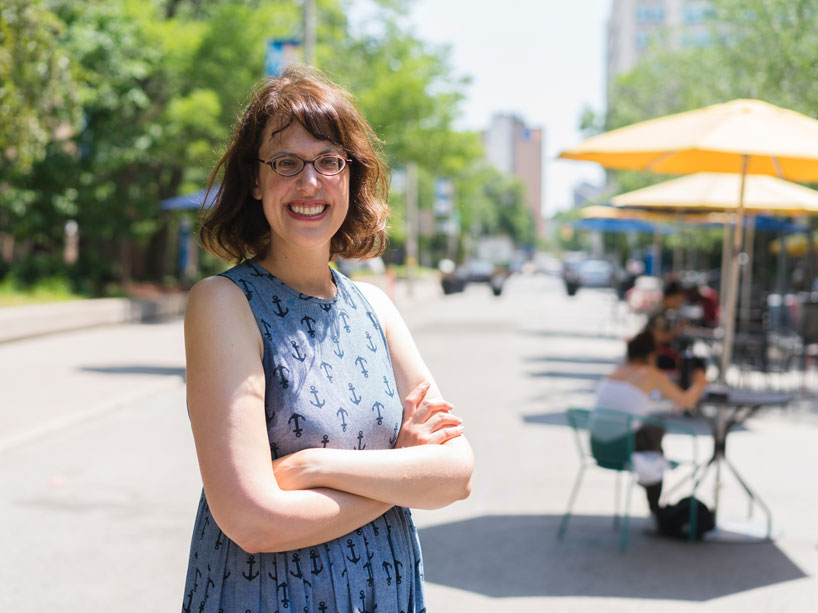Whatever happened to your lost umbrella?

Photo: Sarah Amato is the Faculty of Community Services and Faculty of Arts’ Artist-in-Residence, and will be on campus through July. Photo by Anthony Esguerra.
On New Year’s Day, Sarah Amato lost her hat on Edmonton’s public transit system. Stuck at the office on a very quiet day, she decided to call the lost-and-found to see if anyone had turned it in. She didn’t find the hat, but she did strike up a conversation that would inspire her.
“I learned all sorts of things about what is in the lost and found in public transit,” says Amato. “There really isn’t anything you can imagine that is not eventually turned in. As she explained to me, people carry things with them as they go places, so it’s only natural that things fall by the wayside.”
This summer, Sarah Amato will be on the Ryerson campus as the Faculty of Community Services and the Faculty of Arts Artist-in-Residence. While here, she’ll be working on her art project Is This Your?, which documents lost and found objects. Drawing on personal stories from a range of interviewees, Amato will invite us to look differently at the mittens, keys, umbrellas, and bags that so are so often lost—as well as some objects you might not expect.
What gets lost on the Edmonton public transit system? “There are regular things—the backpacks, the wallets, the lunchbags with full lunches, the water bottles, the jewelry, the credit cards, all manner of ID, a huge amount of cash,” says Amato. “Then there are strange things, like toilet seats, tons of tools, full bags of hockey equipment and golf equipment. There are prosthetics of various sorts—legs, arms, eyes, dentures of various sorts, and, hilariously, sex toys…”
“The conversation with the customer service associate turned to underwear… She told me that she’d never had a bra in her pocket on public transit, but people clearly do. There are things going on that we don’t know about—imagine what kind of life is out there. Then I knew I had a project!”
The project invites us to consider these objects after they leave us. Does their presence or absence change us? How do they change the people who find them? How many of them are merely forgotten, and which ones linger in the memory? Whether it takes the form of a book, an exhibit, or both, the project will be as much about the storytellers as the objects.
One of Amato’s favourite stories came from a recent visit to a seniors’ centre. Amato talked to a woman who remembered an incident 70 years ago when she found an envelope filled with cash and a pay stub. “She took it home and gave it to her father. She said to me that they were by no means wealthy at the time. ‘My dad was an immigrant, and we lived very simply, but my dad immediately recognized that someone had cashed their wages.’”
The father managed to find the person who lost the money. “These people came by public transit to their house to collect their wages, and it was immediately apparent that they were just on the border of being destitute. They were extremely grateful—his wife was pregnant. He came back again and brought her some colouring books. She was 10 at the time, and beyond the age of crayons and colouring books, but the gesture taught her a real lesson in honesty.”
Amato’s participatory art projects have appeared in Nuit Blanche Edmonton and Alberta’s Borealis Gallery, and have tackled topics ranging from women’s suffrage (external link) to potholes (external link) . She has written the book Beastly Possessions: Animals in Victorian Consumer Culture (external link) and taught courses on material culture and modern British history at the University of Toronto, the Ontario College of Art and Design, and Wilfrid Laurier. Her art is heavily informed by her academic work: “I used to teach material culture courses. This project is an example of what I used to assign to my students. When I stopped being an academic, one of the things I missed was this kind of quirky project—and I started doing it myself.”
As artist-in-residence, Amato will be available in July for informal sessions with faculty and students interested in developing art and community-engagement projects (you don’t need to be an artist to participate). And if you have a lost-and-found story, Amato wants to hear it: “I don’t think they have to be ‘good stories.’ Some of the funniest lines are things like, ‘I lose screwdrivers—always screwdrivers,’ or someone said to me in passing, ‘What happens to all the socks in the dryer?’”
Amato can be reached at sarahamato.com (external link) .
*
The Faculty of Community Services and Faculty of Arts Artist-in-Residence position is made possible by the John C. Eaton Chair of Social Innovation and the Jack Layton Chair of Social Justice.